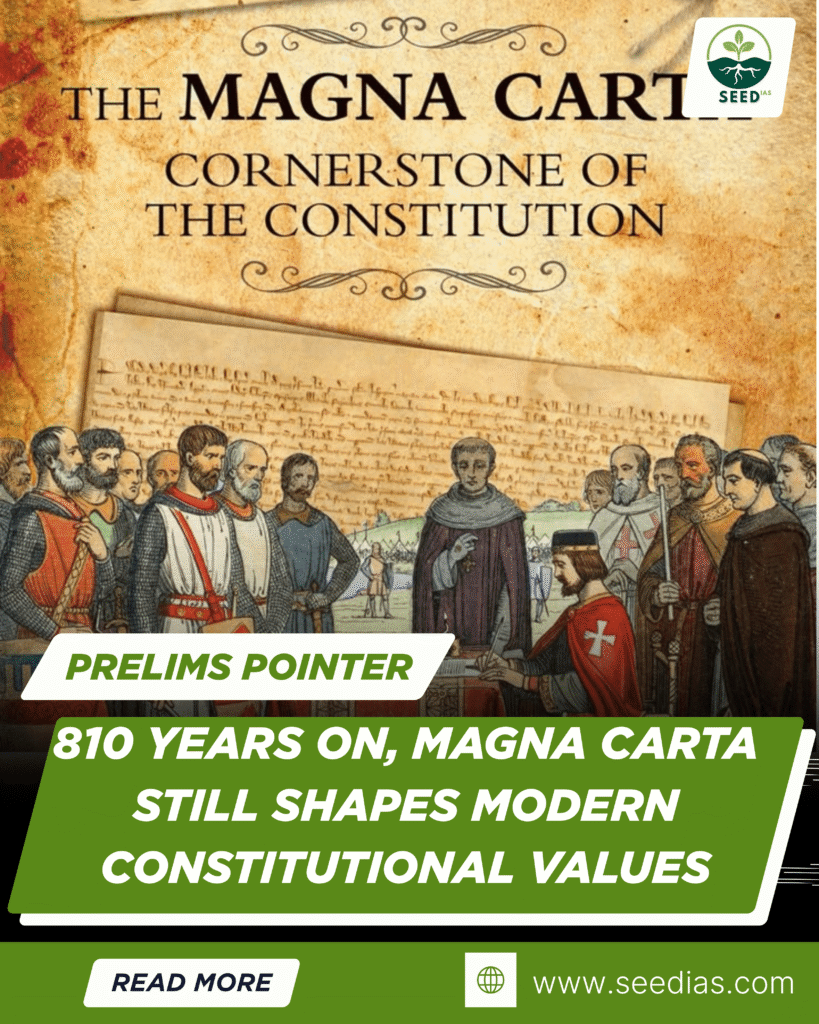Why in NEWS
The rediscovery of a rare Magna Carta manuscript at Harvard University has reignited global conversations on its historical role in advancing rule of law, limited government, and human rights, even eight centuries after its signing in 1215.
Key Concepts and Terms
| Term | Explanation |
|---|---|
| Magna Carta | Latin for “Great Charter”; a 1215 agreement between King John and his barons, limiting royal authority. |
| Rule of Law | Principle that no one, including the king or government, is above the law. |
| Habeas Corpus | Legal safeguard against unlawful detention, rooted in Magna Carta’s legacy. |
| Clause 39 | No imprisonment without lawful judgment. |
| Clause 40 | Justice must not be sold, denied, or delayed. |
| Runnymede | Site near London where Magna Carta was signed on 15 June 1215. |
News Details
- The Magna Carta, originally created to limit King John’s authoritarian rule, remains a symbol of legal accountability.
- Its Clause 39 and 40 became foundational ideas for future legal systems, advocating fair trial, access to justice, and protection from arbitrary state power.
- Though intended to protect elite barons, its ideas expanded over time to inspire modern constitutionalism, including:
- The U.S. Constitution
- English Bill of Rights (1689)
- Universal Declaration of Human Rights (1948)
- The rediscovery at Harvard has brought fresh attention to its global democratic legacy.
About Magna Carta (1215)
| Feature | Details |
|---|---|
| Signed | 15 June 1215 at Runnymede, England. |
| Context | Barons revolted against King John’s high taxes and failed military campaigns. |
| Clauses | 63 original clauses; key ones stress liberty and legal rights. |
| Initial Impact | Quickly annulled but reissued multiple times in later years. |
| Legacy | Cornerstone of British constitutional law and global democratic frameworks. |
In a Nutshell (Mnemonic: MAGNA LAW)
Monarchs limited by law
Arbitrary rule resisted
Guarantee of legal trial
Not above the law (king included)
Access to justice ensured
Legacy for US and UK constitutions
Anti-tyranny symbol
Worldwide inspiration for liberty
Prelims Practice Questions
- Which clause of the Magna Carta prohibits arbitrary arrest and imprisonment?
A. Clause 12
B. Clause 25
C. Clause 39
D. Clause 60 - The Magna Carta was originally signed by which English monarch?
A. Henry III
B. Edward I
C. William the Conqueror
D. King John - Which of the following principles is most closely associated with Magna Carta?
A. Divine right of kings
B. Rule of law
C. Centralized monarchy
D. Economic liberalization
Answers to Prelims Questions
| Q.No | Answer | Explanation |
|---|---|---|
| 1 | C | Clause 39 ensures protection against arbitrary detention. |
| 2 | D | King John of England signed Magna Carta in 1215. |
| 3 | B | Magna Carta is the foundation of the modern rule of law concept. |
















